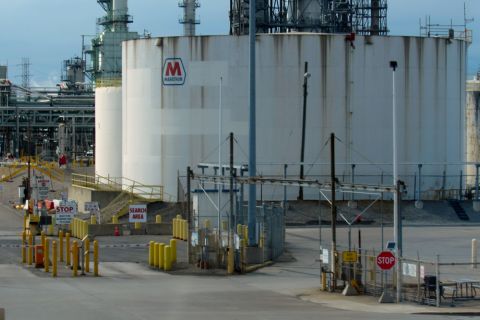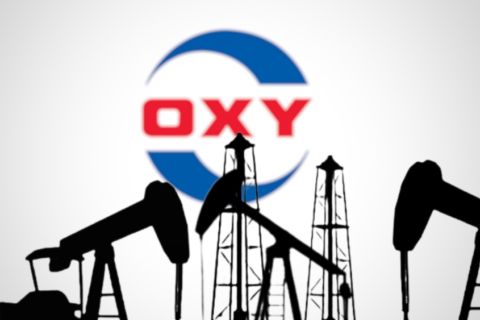
Erin Petkovich, director of Northeast business development for Enbridge Inc., discusses the challenges of moving natural gas to New England at the recent Marcellus-Utica Midstream Conference in Pittsburgh. Source: Hart Energy
PITTSBURGH—During the recent mega-cold snap known as the “bomb cyclone,” it’s been reported that New England burned almost 2 million barrels of oil in 15 days.
Erin Petkovich, who leads Enbridge Inc.’s (NYSE: ENB) business development team in the Northeast region, recounted how Matthew Beaton, Massachusetts’ environment and energy secretary declared the frenzied burning “a disaster both economically and environmentally.”
Shortly after the storm, Bloomberg reported that New England had become the world’s priciest natural gas market. What’s a region to do?
Petkovich, speaking at Hart Energy’s recent Marcellus-Utica Midstream Conference, outlined several of Enbridge’s developing projects that could help New England receive a steady supply of Appalachian natural gas, bolstering its readiness for the next bitter winter storm.
The need exists
While customers pay the highest electricity prices in the continental U.S., the region’s power producers experience a large disparity between the origin price of the natural gas supply and the New England market price,” meaning there is a market opportunity for natural gas suppliers.
Of the early 2018 bomb cyclone, Petkovich said that “[Grid operator] ISO New England said that New England would have been one more bad ice storm away from rolling blackouts … I do not want to be in a rolling blackout scenario when it is 11 degrees outside—I want that electricity on to ignite my burners so that my house is warm and electrified.”
Even when a winter is comparatively mild in New England and the Northeast, New England features a power-generation infrastructure with wide gaps in backup stability.
“We have 25 plants on our system, which represents about 60% of the gas-fired generation for ISO New England. But only about 4% of the power plant load is backed up by firm, mainline pipe capacity to the supply,” Petkovitch said.
On top of the gapped infrastructure, over the past several years, natural gas has grown to 50%—from a previous 15%—of the region’s electricity fuel mix, she said. “But over time, there hasn’t been any new pipeline infrastructure that supports natural gas-power generation.”
Enbridge has plans to provide some of that infrastructure, which would help prevent such strain in the future but natural gas pipelines have faced significant resistance in the region from environmental activists.
“I wouldn’t say that they are necessarily rolling out the red carpet for pipeline infrastructure in Boston, [but] it has gotten a lot more attention—the value and need for reliable energy and secure fuel has been in the headlines much more over the last five weeks,” said Petkovich, who lives in Boston.
“The loudest voices that are being heard are those that oppose fossil fuel infrastructure and fossil fuels in general in New England, even though they don’t represent the majority,” she said.
Massachusetts, she said, requires greenhouse-gas emissions to be cut by 80% by 2050. However, in January, 40% of the state’s electricity came from coal and oil while wind and solar provided between 2% and 6%.
“To set the stage, we have just seen significant support for the Northeast markets from Marcellus and Utica supply,” she said. Among the Enbridge lines that can provided a stable and affordable gas supply are Axis Northeast, Atlantic Bridge and Nexus, she said.
Using Axis Northeast and an expanded Algonquin system for power generation will not only alleviate cost and reliability concerns but, she said, “it will also bolster renewable development, as we see natural gas as a great complimentary backup and support of New England’s renewable targets, and even, laws.”
Access Northeast, which is specifically designed to move natural gas for power generation, Petkovitch said, would help ensure sufficient supply to heat the region’s homes.
“We’re well positioned, being connected to the plants, and we can develop [natural gas reliability for power generation] in an environmentally responsible and cost-effective manner,” she said, noting that Enbridge is working with the New England states on uniform energy policy for gas infrastructure, along with partners EverSource Energy and National Grid.
Expanding Algonquin, which supplies New England (as opposed to supplying the greater Northeast) with most gas coming through the Millennium, Tennessee and Texas Eastern lines, will also help reinforce power generation cost and reliability, she said.
The work on Atlantic Bridge, “an expansion of our existing pipeline systems in Algonquin and the [Canadian Maritimes] and Northeast … will be the first time that we connect our northern New England and Atlantic Canada LDC [local distribution company] and industrial customers with Marcellus Shale supply,” Petkovich said.
‘Not Giving Up’
Atlantic Bridge will expand the existing Algonquin and Maritimes lines by about 135 million cubic feet per day (MMcf/d) of capacity, allowing supply distribution to LDCs in New England and Atlantic Canada. The new regional supplies would flow up the East Coast, roughly from New York to Halifax, Nova Scotia. Petkovitch said she was pleased that the project’s Federal Energy Regulatory Commission (FERC) certificate was received in January 2017, but was even more pleased that a state water quality permit was more recently received.
In May 2017, the company received its 401 Water Quality permit from the state of New York.
“I’m sure you know that state permits—and especially state permits in New York—are not something to be taken for granted,” she said. “We feel that our ability to execute and construct in a safe and reliable environmentally responsible manner, and our relationships we have with state and local officials and stakeholders in the region, have been the key to our success.”
Atlantic Bridge is just one more push that Petkovitch said signifies that Enbridge is “not giving up on the Northeast and New England.”
Erin Pedigo can be reached at epedigo@hartenergy.com.
Recommended Reading
Marathon Chasing 20%+ IRRs with Los Angeles, Galveston Refinery Upgrades
2024-02-01 - Marathon Petroleum Corp. is pursuing improvements at its Los Angeles refinery and a hydrotreater project at its Galveston Bay refinery that are each boasting internal rate returns (IRRs) of 20% or more.
Marathon Petroleum Sets 2024 Capex at $1.25 Billion
2024-01-30 - Marathon Petroleum Corp. eyes standalone capex at $1.25 billion in 2024, down 10% compared to $1.4 billion in 2023 as it focuses on cost reduction and margin enhancement projects.
Moda Midstream II Receives Financial Commitment for Next Round of Development
2024-03-20 - Kingwood, Texas-based Moda Midstream II announced on March 20 that it received an equity commitment from EnCap Flatrock Midstream.
Buffett: ‘No Interest’ in Occidental Takeover, Praises 'Hallelujah!' Shale
2024-02-27 - Berkshire Hathaway’s Warren Buffett added that the U.S. electric power situation is “ominous.”
Humble Midstream II, Quantum Capital Form Partnership for Infrastructure Projects
2024-01-30 - Humble Midstream II Partners and Quantum Capital Group’s partnership will promote a focus on energy transition infrastructure.





